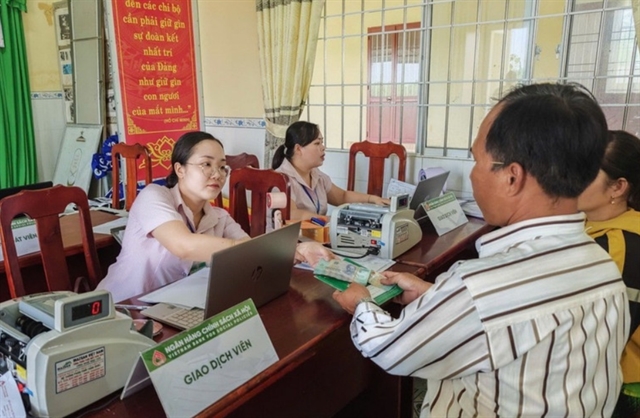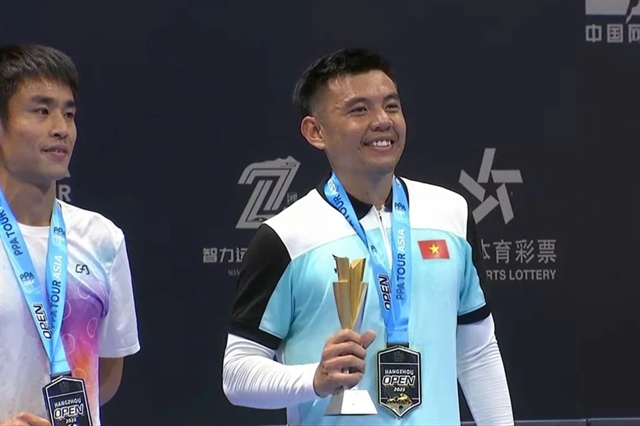

For more than two hundred years, a village in Nam Định Province has produced bells.

|
| Bell casting has existed in the village for more than 200 years. Photo anninhthudo.vn |
By Hà Nguyễn & Hoàng Hồ
The ancient Catholic village of Kiên Lao in Nam Định Province is well known for its bronze casting.
Nowadays, it also produces machinery for construction projects across the country.
Mai Văn Tân, chairman of Xuân Tiến Village (as it is now known), says: “Bell casting has been around for more than 200 years, and there is still room to develop.”
Village elder Lê Văn Hào says the craft was founded by Lê Văn Nghiêm, who took the art of casting the famous Đông Sơn bronze drums in Thanh Hóa to Kiên Lao.
The last six generations of the Lê Văn clan have continued his work and provided stable jobs for local people.
From the youngest generation, Lê Văn Kha says his workshop produces bells and statues weighing from 0.5-7 tonnes.
“I was born into a bronze casting family, so I know how to fire up the furnace and combine the right ratio of bronze and tin, as well as designing patterns on items such as bells,” Kha says.
To make a bronze bell, a worker first has to make a mould from clay mixed with rice husks. The mould is then fired to harden it, and while it cools workers design patterns inside before firing it again, he says.
The most important part of the process is the bronze casting itself. Only skilled workers know when the molten metal is ready to pour it in the mould, Kha says.
“We have to work carefully through each stage to ensure quality,” he says.
Thanks to this meticulous process, customers from across the country order his items. Hà Tĩnh ordered a 5-tonne bell to place at the Đồng Lộc crossroads, while the Spratly Islands commissioned a 7-tonne bell to hang on the archipelago.
Kha’s younger brother, Lê Văn Khiêm, is an expert in casting bronze statues.
“Kiên Lao casts are always high quality thanks to the dedicated workers. The process of polishing the statues is very important to ensure their longevity," Khiêm says.
“I still need to improve my skills and accumulate experience every day. That's my secret,” he says.
Painter Trần Hoàng from Hà Nội says: “People can see the soul in Khiêm’s statues of President Hồ Chí Minh and village gods, particularly in his Buddha statues that can be found in many pagodas across the country.”
To cast a statue, a worker needs skilled hands and a rich imagination, and more importantly they need to know the correct size, physical form, costumes and characteristics of each statue.
Hoàng says he was impressed with Khiêm’s Buddha statues because of their expressions of mercy, leniency and sublimity.
Khiêm says in most villages, the traditional job is handed down to male heirs, but in Kiên Lao, both men and women pursue the job.
Mai Văn Hậu from the Lê Văn clan says his workshop have created stable jobs for a dozen workers with monthly salaries of VNĐ6-10 million per person.
“We produce different kinds of bells; some for churches and others for pagodas. Each bell has its own sound. The church bells have a higher pitch while pagoda bell emits a lower tone,” Hậu says.
A perfect bell should ensure the right tone, shape and designs, he says.
Hậu’s fame has spread far and wide. He has received orders to cast Buddha statues for pagodas and temples throughout the country, including Vàng Pagoda in Tam Đảo and Thiện Sơn Pagoda in Vĩnh Phúc Province, and a statue of national hero Trần Hưng Đạo for Thăng Phúc Pagoda in Hải Phòng.
His workshop also cast a bell for Thăng Long Citadel for the 1,000th anniversary of the capital city of Hà Nội. The bell hangs in Kính Thiên Palace inside the Citadel.
Hậu’s three younger brothers all have their own workshops.
One of them, Mai Văn Phương, says: “We are Catholic but we know about Buddha and other religions. We do a lot of research for our work.”
“Even though we are busy with new orders, we are preparing to welcome Christmas by decorating our homes and buying new clothes for the festive church service.” VNS
GLOSSARY
The ancient Catholic village of Kiên Lao in Nam Định Province is well known for its bronze casting.
Casting is pouring hot, liquid metal to change it into a new shape.
Mai Văn Tân, chairman of Xuân Tiến Village (as it is now known), says: “Bell casting has been around for more than 200 years, and there is still room to develop.”
Bell casting is the making of bells using casting.
Village elder Lê Văn Hào says the craft was founded by Lê Văn Nghiêm, who took the art of casting the famous Đông Sơn bronze drums in Thanh Hóa to Kiên Lao.
A craft is a skilled activity one does using one’s hands.
Founded means started.
The last six generations of the Lê Văn clan have continued his work and provided stable jobs for local people.
Your children are one generation; you, your brothers and sisters are another generation; your parents and their brothers and sisters (your aunts and uncles) are yet another generation, and so on.
“I was born into a bronze casting family, so I know how to fire up the furnace and combine the right ratio of bronze and tin, as well as designing patterns on items such as bells,” Kha says.
A furnace is a very hot oven, used for things like pottery and metal casting rather than cooking food.
Combine means “join”.
Ratio is proportion.
To make a bronze bell, a worker first has to make a mould from clay mixed with rice husks.
A mould is a device that hot, liquid metal is poured into in order to make it a certain shape.
Clay is a type of mud used to make pottery.
Rice husks are a part of the rice plant that is not eaten.
Only skilled workers know when the molten metal is ready to pour it in the mould, Kha says.
Molten metal is hot, liquid metal.
“We have to work carefully through each stage to ensure quality,” he says.
Quality is the measure of something being in a good state, or not.
Thanks to this meticulous process, customers from across the country order his items.
A meticulous process is one that needs to follow procedures very exactly.
Hà Tĩnh ordered a 5-tonne bell to place at the Đồng Lộc crossroads, while the Spratly Islands commissioned a 7-tonne bell to hang on the archipelago.
To commission a bell to be made means to ask a caster to make one especially for you.
An archipelago is a group of islands.
“Kiên Lao casts are always high quality thanks to the dedicated workers.”
Workers who are dedicated make doing their work properly a very important part of their lives.
“The process of polishing the statues is very important to ensure their longevity," Khiêm says.
Polishing means rubbing something so that it shines.
Ensure means “make sure”.
Longevity means having a long life.
“I still need to improve my skills and accumulate experience every day. That's my secret,” he says.
Accumulate means “gather”.
To cast a statue, a worker needs skilled hands and a rich imagination, and more importantly they need to know the correct size, physical form, costumes and characteristics of each statue.
Imagination is the dreaming up of ideas using creative thinking.
Hoàng says he was impressed with Khiêm’s Buddha statues because of their expressions of mercy, leniency and sublimity.
To have mercy means to be nice to someone you have the power to harm.
If you have leniency, you show more mercy than people expect you to show.
Sublimity means “being wonderful”.
Khiêm says in most villages, the traditional job is handed down to male heirs, but in Kiên Lao, both men and women pursue the job.
Heirs are people who inherit something from someone else when that person dies.
To pursue a job means to go ahead and do it.
Mai Văn Hậu from the Lê Văn clan says his workshop have created stable jobs for a dozen workers with monthly salaries of VNĐ6-10 million per person.
A dozen means many but, more precisely, it means twelve.
“The church bells have a higher pitch while pagoda bell emits a lower tone,” Hậu says.
A pitch is a measure of a musical sound.
Emits means “lets out”.
A tone is a musical sound
WORKSHEET
Find words that mean the following in the Word Search:
c | i | w | a | b | n | l | s | a | s |
a | c | g | r | i | b | p | h | r | p |
t | s | c | h | a | n | d | s | i | r |
h | e | t | w | e | d | t | y | v | a |
o | o | g | r | u | e | n | z | e | t |
l | u | z | b | e | l | l | r | d | l |
i | a | c | k | f | r | u | i | t | y |
c | u | r | n | l | e | a | n | l | i |
ANSWERS: 1. Buddha; 2. Catholic; 3. Bell; 4. Spratly; 5. Hands.



